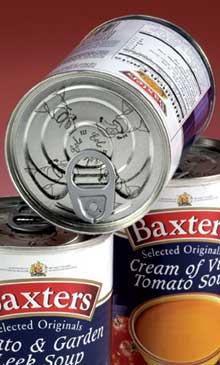

North America’s food manufacturers use almost 31 billion metal food cans a year, according to Maggie Springer, marketing strategist with Akron, Ohio-based Ingenium Packaging LLC. Processors have been divesting their captive can-making units in droves since 1990, leaving three firms with 85 percent of the market: Silgan Holdings, Crown Cork & Seal and Ball Corp. “The can industry has sat there for two decades without innovating,” Springer maintains, so the surviving firms are chasing a flat growth curve.
Ingenium’s solution is a thin wall, pressurized can with a concave end, a sterilizable packaging solution invented by George B. Diamond and patented four years ago. Though the cans use 40 percent less steel than conventional units to deliver a more rigid structure, Ingenium’s efforts to license the technology failed because can makers were reluctant to agree to sell the units for less. As a result, Ingenium is building a production facility in Emporia, Kan., with a second plant in Alliance, Ohio, on the drawing board.
Liquid nitrogen dosing and a vacuum are used to create up to 20 psi of internal pressure in the cans prior to retort. That pressure prevents outside air from being drawn into the can during cool down, a major cause of post-processing contamination. If a pinhole exists in the can, it emerges from the retort as an easily detected limp unit.
Four decades have lapsed since the pop-top beverage can debuted. Only in recent years have food can manufacturers taken a stab at incorporating this convenience feature, often with lukewarm success. To maintain packaging integrity, early versions of self-opening cans required opening force that was anything but easy. As a consequence, only 10 percent of U.S. food cans sport an easy-open lid, though several major processors have begun adding this feature.
Campbell’s ready-to-serve soups began appearing with pop tops in 2001, though its condensed soups remain in traditional cans. Nestle’s pet-care division introduced the EZOpen lid on cans of Alpo dog food last year, and other manufacturers are following suit.
“Finding the proper balance between pop force and tear-and-peel force for easy-open metal cans has been a challenge,” allows Raymond L. McGowan Jr., who recently was named president of the U.S. food can division of Crown Cork & Seal. The company is rolling out the third iteration of its Easy Opening, Low Energy (EOLE) ends, which incorporate seeming changes and other refinements. The force needed to pop the lids is about half that of the first generation EOLE ends, McGowan says, and tear force also has been reduced.
Shaping technology is another innovation that can makers hope will add sizzle to their packaging and help them compete more effectively with rigid and flexible plastic enclosures. Beer manufacturers blazed this trail with 24 oz. Heineken’s pub cans and Adolph Coors’ Killian’s sleeved aluminum cans, and the same concept is being applied to steel cans.